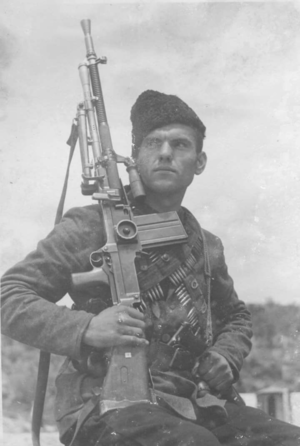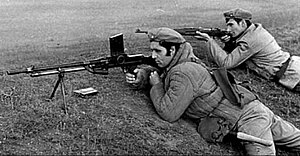ZB vz. 30
| Vz. 30 | |
|---|---|
 Yugoslav-made ZB vz. 30 | |
| Type | Light machine gun |
| Place of origin | Czechoslovakia |
| Service history | |
| In service | 1930–2009[1] |
| Used by | See Users |
| Wars | Chaco War[2] Second Italo-Ethiopian War[3] Spanish Civil War[4] World War II First Indochina War Algerian War Biafran war War in Afghanistan (2001–present)[1] |
| Production history | |
| Designed | 1930 |
| Manufacturer | Zbrojovka Brno, Military Technical Institute Kragujevac[5] |
| Specifications | |
| Mass | 9.10 kg (20.06 lb) |
| Length | 1,180 mm (46.5 in) |
| Cartridge | 7.92×57mm Mauser |
| Action | Gas-operated, tilting breechblock |
| Rate of fire | 550-650 rounds/min |
| Muzzle velocity | 750 m/s (2,461 ft/s) |
| Effective firing range | 1,000 m (1,100 yd) |
| Feed system | 20-round detachable box magazine |
| Sights | Front blade, rear leaf sight |
The ZB-30 and ZB-30J were Czechoslovakian light machine guns that saw extensive use during World War II.
History
The Zb 30 and Zb 30J were the later versions of the famous Czechoslovak machine gun, the ZB-26. However, the ZB-30 had some design differences, making it similar to the later ZGB-33, which was an early prototype of the Bren gun.[6] Like the ZB-26, the Wehrmacht adopted the ZB-30 after the occupation of Czechoslovakia, renaming it the MG30(t); it was used in the same role as the MG34, as a light machine gun. In the opening phases of World War II, the ZB-30 in 7.92 mm Mauser caliber was used in large numbers by elements of the German Waffen SS, who did not initially have full access to standard Wehrmacht supply channels.[1]
Comparison of original ZB vz.26 and modifications:
| Machine gun | ZB vz.26 | ZB vz.30 | ZB vz.30J |
|---|---|---|---|
| Caliber (mm) | 7.92 | 7.92 | 7.92 |
| Length (mm) | 1165 | 1180 | 1204 |
| Weight (kg) | 8.84 | 9.10 | 9.58 |
| Magazine (rounds) | 20 | 20 | 20 |
| Rate (round/min) | 500 | 550-650 | 500-600 |
| Velocity (m/s) | 750 | 750 | 750 |
Users

 Afghanistan: 2,000 shipped in 1938[7]
Afghanistan: 2,000 shipped in 1938[7] Algeria: used by the National Liberation Army.[8]
Algeria: used by the National Liberation Army.[8] Biafra[9]
Biafra[9] Bolivia: 3,350 in 7.65mm Mauser between 1932 and 1937,[7] used in the Chaco War[2]
Bolivia: 3,350 in 7.65mm Mauser between 1932 and 1937,[7] used in the Chaco War[2] Bulgaria: used as aircraft gun on Kaproni Bulgarski KB-11 Fazan[citation needed]
Bulgaria: used as aircraft gun on Kaproni Bulgarski KB-11 Fazan[citation needed] Czechoslovakia[10]
Czechoslovakia[10] Republic of China: Imported and produced under license.[11]
Republic of China: Imported and produced under license.[11] Ecuador 750 in 1935-1936[7]
Ecuador 750 in 1935-1936[7] Ethiopia: 400-450 ZB vz.30 bought in 1934, used by the Kebur Zabagna[3][7]
Ethiopia: 400-450 ZB vz.30 bought in 1934, used by the Kebur Zabagna[3][7] Nazi Germany
Nazi Germany Guatemala: 50 in 7mm Mauser, delivered in 1937[12][7]
Guatemala: 50 in 7mm Mauser, delivered in 1937[12][7] Iran[13]: produced under license. Modified to fire the .30 cardridge.[14]
Iran[13]: produced under license. Modified to fire the .30 cardridge.[14] Japan: used captured Chinese guns.[15]
Japan: used captured Chinese guns.[15] Latvia: 11 received in 1936[7]
Latvia: 11 received in 1936[7] Manchukuo[16]
Manchukuo[16] Nicaragua: 5 supplied in 1937[7]
Nicaragua: 5 supplied in 1937[7] Peru: 1,257 in 7.65mm, delivered from 1932 to 1938[7]
Peru: 1,257 in 7.65mm, delivered from 1932 to 1938[7] Romania: Produced under license.[1][17] 17,131 were imported from Czechoslovakia from 1933[7][18] and 10,000 were licence-produced at Cugir,[19] with a production rate of 250 pieces per month as of October 1942.[20]
Romania: Produced under license.[1][17] 17,131 were imported from Czechoslovakia from 1933[7][18] and 10,000 were licence-produced at Cugir,[19] with a production rate of 250 pieces per month as of October 1942.[20] Spain: 20,000 guns ordered[1] but only a few hundred actually delivered. Copied as the Fusil ametrallador Oviedo.[21]
Spain: 20,000 guns ordered[1] but only a few hundred actually delivered. Copied as the Fusil ametrallador Oviedo.[21] Turkey: 9,805 supplied in 1935–1939.[7] Produced under license[1]
Turkey: 9,805 supplied in 1935–1939.[7] Produced under license[1] Uruguay: 80 in 7mm received in 1937[7]
Uruguay: 80 in 7mm received in 1937[7] Venezuela: 110 ZB-30J received in 1937[7]
Venezuela: 110 ZB-30J received in 1937[7] Vietnam: Used by the Việt Minh, supplied by both Nationalist and Communist Chinese[22]
Vietnam: Used by the Việt Minh, supplied by both Nationalist and Communist Chinese[22] Yugoslavia: The ZB Model 30J was produced under license as, Пушкомитраљез 7.9mm модел 1937".[23][24] 15,500 were bought in 1936.[7]
Yugoslavia: The ZB Model 30J was produced under license as, Пушкомитраљез 7.9mm модел 1937".[23][24] 15,500 were bought in 1936.[7]
References
- ^ a b c d e f Grant 2013, p. 65.
- ^ a b Alejandro de Quesada (20 November 2011). The Chaco War 1932-35: South America's greatest modern conflict. Osprey Publishing. p. 24. ISBN 978-1-84908-901-2.
- ^ a b "ZB VZ 30". iwm.org.uk. Imperial War Museum.
- ^ de Quesada, Alejandro (20 Jan 2015). The Spanish Civil War 1936–39 (2): Republican Forces. Men-at-Arms 498. Osprey Publishing. p. 38. ISBN 9781782007852.
- ^ http://www.zastava-arms.rs/sr/imagetext/1919-1941
- ^ Modern Firearms - ZB 26
- ^ a b c d e f g h i j k l m Fencl, Jiří (1991). "Nejprodávanější československá zbraň" (in Czech). Militaria, Elka Press. Retrieved 12 March 2019.
- ^ "StG-44 in Africa after WWII". wwiiafterwwii.wordpress.com. 27 September 2015.
- ^ Jowett, Philip (2016). Modern African Wars (5): The Nigerian-Biafran War 1967-70. Oxford: Osprey Publishing Press. p. 22. ISBN 978-1472816092.
- ^ Grant 2013, p. 10.
- ^ Jowett, Philip S. (1997). Chinese Civil War Armies 1911-49. Men at Arms 306. Osprey Publishing. p. 36. ISBN 1855326655. Retrieved April 24, 2014.
{{cite book}}: Invalid|ref=harv(help) - ^ Perutka, Lukáš (September 2014). Checoslovaquia, Guatemala y México en el Período de la Revolución Guatemalteca: Ibero-Americana Pragensia - Supplementum 32/2013 (in Spanish). Karolinum Press. p. 36. ISBN 978-80-246-2429-7.
- ^ "Fusils-mitrailleurs Lehky Kulomet ZB vz.26 and vz.30". Encyclopédie des armes : Les forces armées du monde (in French). Vol. II. Atlas. 1984. p. 262.
- ^ Smith 1969, p. 463.
- ^ Smith 1969, p. 498.
- ^ Jowett, Philip S. (2010). Rays of the rising sun : armed forces of Japan's Asian allies, 1931-45. Vol. 1, China & Manchukuo. Helion. p. 15. ISBN 9781906033781.
- ^ Smith 1969, p. 535.
- ^ Mark Axworthy, London: Arms and Armour, 1995, Third Axis, Fourth Ally: Romanian Armed Forces in the European War, 1941–1945, p. 29
- ^ John Walter, Greenhill Books, 2004, Guns of the Third Reich, p. 86
- ^ Mark Axworthy, London: Arms and Armour, 1995, Third Axis, Fourth Ally: Romanian Armed Forces in the European War, 1941–1945, p. 75
- ^ "Fusil Ametrallador Oviedo (FAO): otro capítulo más de nuestra gloriosa historia armera". arma.es (in Spanish). 24 March 2017.
- ^ Windrow, Martin (20 Sep 2018). French Foreign Légionnaire vs Viet Minh Insurgent: North Vietnam 1948–52. Combat 36. Osprey Publishing. pp. 24–25. ISBN 9781472828910.
- ^ http://www.zastava-arms.rs/en/imagetext/1919-1941
- ^ Smith 1969, p. 320.
- McNab, Chris: Twentieth-century Small Arms, Grange Books, 2004; ISBN 1-84013-381-3
- Grant, Neil (2013). The Bren Gun. Weapon 22. Osprey Publishing. ISBN 978-1782000822.
{{cite book}}: CS1 maint: ref duplicates default (link) - Smith, Joseph E. (1969). Small Arms of the World (11 ed.). Harrisburg, Pennsylvania: The Stackpole Company.
{{cite book}}: Invalid|ref=harv(help)
